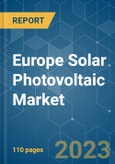The Europe solar photovoltaic (PV) market is anticipated to grow at a CAGR of 12% during the forecast period.
This product will be delivered within 2 business days.
Key Highlights
- Over the medium term, factors such as rising demand for electricity across the region and the European Union’s objective to become carbon neutral and produce most of the electricity from renewable sources have driven the growth of the market.
- On the other hand, the rising consumption of natural gas and the availability of this gas at lower prices for power generation poses as growth-hampering factors for the market in the European region.
- Nevertheless, the increasing investment in solar power generation increases the demand for solar modules. Furthermore, different initiatives and policies have also been adopted by governments across the region. For instance, the REPowerEU Plan and the Feed-in Tariff (FIT) are implemented to boost solar PV installation and are expected to create lucrative opportunities for the market during the forecast period.
- Germany, with the largest installed capacity of solar photovoltaics, is expected to dominate the European solar photovoltaics (PV) market during the forecast period.
Europe Solar Photovoltaic (PV) Market Trends
Rooftop Segment Anticipated to Witness Significant Market Growth
- The rooftop segment is estimated to witness significant growth during the forecast period in Europe. The European region's rooftop installation has lots of potential as most of Europe's roof surfaces are unused. Several countries in Europe are working on modifying their policies to assess remuneration levels.
- Furthermore, Norway, the Baltic region, Ireland, and others have geographical conditions favorable to rooftop PV installation. This is expected to increase rooftop solar PV installation in Europe during the forecast period. Also, in several countries, homeowners are willing to install rooftop PV modules to reduce their electricity bills. In 2021, Europe's solar PV installed reached 183.55 GW, with a growth rate of 14.35% over the previous year.
- Governments in several countries have adopted supportive policies to increase the deployment of rooftop PV arrays within the region. For instance, in May 2022, the European Commission announced a mandate for rooftop solar installed on public and commercial and buildings by 2027 and for residential buildings by 2029. The European Union has increased its renewable energy target for 2030 from 40% to 45%.
- Similarly, in August 2021, the European Commission gave a go to the French aid scheme, which is projected to support the rooftop solar development of 3.7 GW. EC has allocated a budget of USD 6.8 billion. The measure runs until 2026, which is likely to be open for PV operator installations with a capacity of up to 500 kW. At the end of June 2021, France's cumulative solar capacity reached approximately 14.7 GW, which is further likely to expand the market share of rooftop solar systems.
Germany Expected to Dominate the Market
- Germany is one of the most lucrative markets in the European region for renewable energy production, including solar. The country has experienced significant developments in solar PV installation due to the target of reducing carbon emissions. The country is likely to continue witnessing growth in solar installation.
- The country has implemented several regulations and incentive schemes to promote the installation of solar modules in cities. In 2020, Berlin adopted the 'Solarcity Master Plan' to expand the deployment of solar panels across the city's rooftops, with an objective of supplying approximately 25% of the city's electricity needs with solar power by 2050. It included 27 recommendations to kickstart the solar development in Berlin, including incentives and education for estate owners and removing regulatory barriers for photovoltaic systems.
- Furthermore, the mandates for solar PV installation on new buildings in a few German cities have helped in the expansion of the market in Germany. In June 2021, the Berlin Solar Act was passed by the Berlin House of Representatives, which requires the installation of solar PV systems on all new buildings from 2023 in Berlin.
- The Renewable Energy Act implemented in Germany, has targets under which new solar PV installations will total 22 GW per year as of 2026 to achieve a total capacity of 215 GW by 2030 and 400 GW by 2040. Also, higher feed-in tariffs for rooftop solar power installations will incentivize the expansion of solar power.
- According to Germany's Federal Network Agency (Bundesnetzagentur), at the end of 2021, the country had a total cumulative photovoltaic capacity of 58.7 GW. Germany installed around 7.2 GW of new solar PV, up 26% in 2022. The significant growth driving factors for solar PV installation in Germany are government regulations and carbon-neutral targets.
Europe Solar Photovoltaic (PV) Market Competitor Analysis
The Europe solar photovoltaic (PV) market is fragmented. Some of the major companies in the market (in no particular order) include Hanwha Q CELLS Technology Co., Ltd, Iberdrola S.A., SunPower Corporation, JinkoSolar Holding Co., Ltd, and Lightsource BP Renewable Energy Investments Limited., among others.Additional benefits of purchasing the report:
- The market estimate (ME) sheet in Excel format
- 3 months of analyst support
This product will be delivered within 2 business days.
Table of Contents
1 INTRODUCTION
4 MARKET OVERVIEW
5 MARKET SEGMENTATION
6 COMPETITIVE LANDSCAPE
Companies Mentioned (Partial List)
A selection of companies mentioned in this report includes, but is not limited to:
- First Solar, Inc.
- Électricité de France S.A. (EDF)
- Hanwha Q CELLS Technology Co., Ltd
- Iberdrola, S.A
- JinkoSolar Holding Co., Ltd
- SunPower Corporation
- Lightsource bp Renewable Energy Investments Limited.
- Enel SpA
- Centrotherm International AG
Methodology

LOADING...










